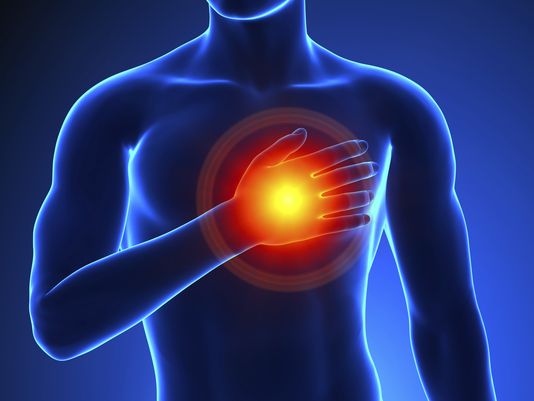Warning Symptoms Can Often Precede Sudden Cardiac Arrest: Cohort Study
By: Pam Harrison
Warning symptoms, notably chest pain and dyspnea, occur during the 4 weeks preceding sudden cardiac arrest (SCA) in at least half of cases involving middle-aged adults, suggests a new study. The warnings are usually ignored, observe researchers, with few patients phoning 911 in response to what is almost always a fatal event.
The analysis based on the Oregon Sudden Unexpected Death (SUD) cohort was published online December 22, 2015 in the Annals of Internal Medicine.
“We always thought that SCD was so unexpected that there wouldn’t be any time to act,” senior author Dr Sumeet Chugh (Cedars-Sinai Heart Institute, Los Angeles, California) told heartwire from Medscape.
“So the first surprise was that sudden death may not be as sudden as we thought,” he said. “But we were also surprised by the fact that there were people who had their symptoms not only in the 24 hours that preceded the arrest, but some who had symptoms in the 4 weeks that preceded their event.” Women and men didn’t differ in their likelihood of having symptoms, he added, but the nature of symptoms was different by sex.
“The whole study was a surprise, and the findings could open a new window of opportunity for the prevention of SCD in middle-aged adults, [in whom] the arrest hits society the hardest because most . . . breadwinners are in this age category.”
The Oregon SUD study is a large, prospective, community-based study of deceased and surviving patients who had an SCA in the Portland, Oregon metropolitan area.
As reported by Dr Eloi Marijon (European Georges Pompidou Hospital, Paris, France) and colleagues, the analysis included 839 patients between 35 and 65 years of age with SCA whose prodromal symptoms could be comprehensively assessed.
Data on symptoms were collected by the Oregon SUD investigators based on information documented by the emergency medical services (EMS) team in the field, intensivists or cardiologists at 16 local hospitals, and physicians in the community.
Of the 839 patients, 430 patients or 51% of the cohort experienced at least one symptom within the 4 weeks preceding their arrest. Men and women experienced prodromal symptoms with equal frequency at 50% vs 53%, respectively.
CLICK HERE for more resources on Fundamentals of Nursing
CLICK HERE for more resources on Laboratory & Diagnostic Test
Symptoms also started more than an hour before SCA onset in 80% of patients; but in 147 of these patients, symptom onset occurred more than 24 hours before their arrest. Among this subgroup of patients, 93% had recurrent new episodes of symptoms during the 24 hours preceding their arrest.
“The main symptom was chest pain, documented in 199 patients,” or 46%, Marijon observed. Of those, 76% had “intermittent typical angina,” he said.
Another 18% of patients had dyspnea as their apparent prodromal symptom; about one-third of this group had established congestive heart failure or a pulmonary condition. Only 5% of the cohort developed syncope or palpitations as presumed prodromal symptoms.
“Men experienced more chest pain than women, whereas women experienced more dyspnea (P<0.001)," write Marijon and colleagues. However, even when the analysis was restricted to patients with documented CHD, chest pain rates at 32% among women were still lower than they were for men at 58% (P=0.001).
Calling 911 and Survival
Among the 430 patients who experienced symptoms prior to SCD, 19% had called EMS before SCA onset. Among the 81 patients who made a 911 call, over three-quarters of them arrested prior to arrival of the EMS team and 22% arrested while in transit to the hospital.
Importantly, however, 32.1% of those who called 911 survived to hospital discharge, compared with only 6% of patients who did not call 911 (P <0.001). In adjusted analysis, making a call to 911 increased the likelihood that patients would survive to hospital discharge by almost fivefold, at an odds ratio (OR) of 4.82 compared with those who did not call (P<0.001). What Can Be Done
“We do have ways to prevent SCA, the most important being the implantable defibrillator,” Chugh said. However, the ability to select appropriate candidates for an implantable defibrillator is still very limited, he added, “so it is going to take us some time to get to this goal.”
That an early call to 911 was associated with better survival odds in the current study suggests there is a potential to enhance short-term prevention of SCA by targeting public awareness of SCA. But, “right now, we can’t say that everybody who has chest pain or shortness of breath should call 911—that would be a disaster,” Chugh said.
“But we do know that we have the potential to make a novel dent in the burden of SCD, and we need to move to the next step where we identify patterns of risk—perhaps a combination of circumstances, clinical profile, and symptoms—that denotes high risk. And if we can identify these patterns, then it could be in that time window, which is 27 days and 23 hours longer than we expected, when patients could reach out to their healthcare provider and something could be done to nip SCA in the bud.”
The study was funded by the National Heart. Lung and Blood Institute. Chugh reports grants from the National Heart, Lung, and Blood Institute, Philip Foundation, Bettencourt Schueller Foundation, French Society of Cardiology, Foundation for Medical Research, and French National Institute of Health and Medical Research outside the submitted work. Marijon and the other coauthors have no relevant financial relationships.
CLICK HERE for more resources on Fundamentals of Nursing
CLICK HERE for more resources on Laboratory & Diagnostic Test

